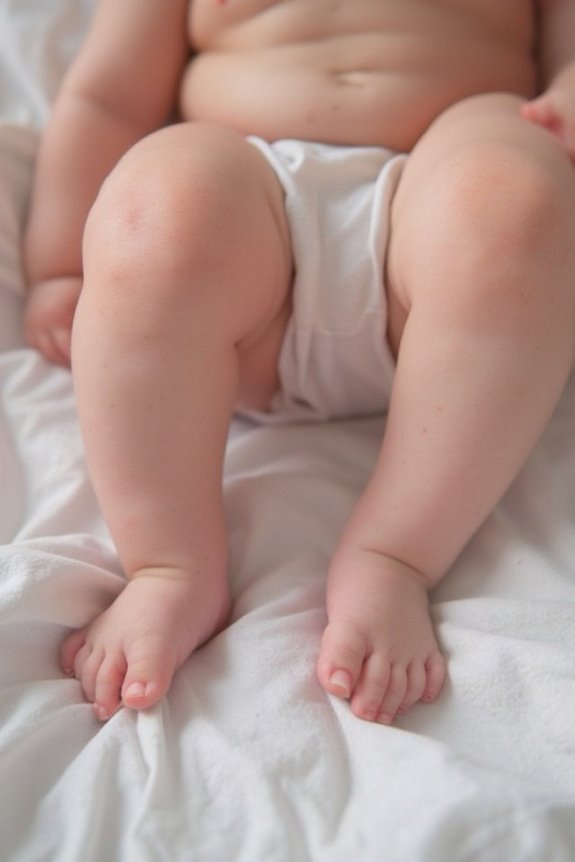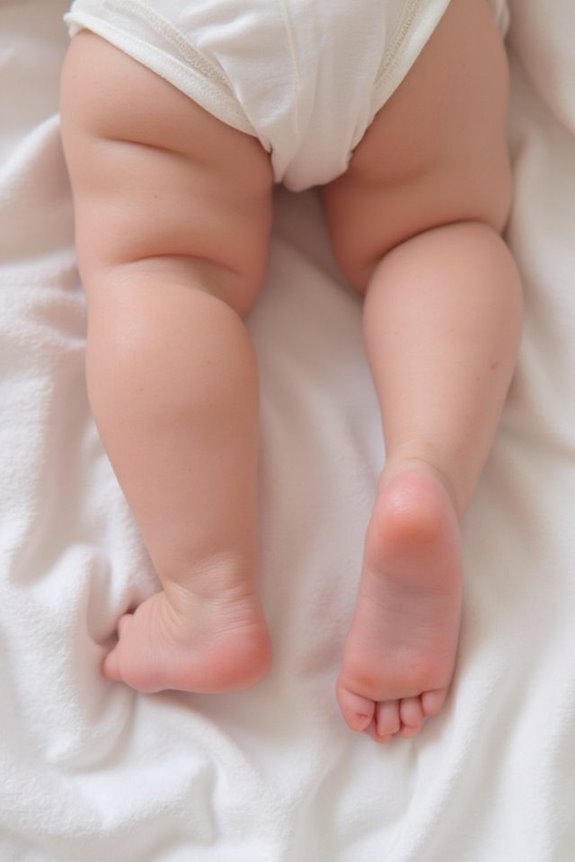Yes, babies do have kneecaps, but they’re made of cartilage rather than bone. This flexible cartilage provides cushioning and allows for easier movement during crawling and early walking stages. The ossification process—where cartilage gradually transforms into bone—typically begins around age 2-3 and completes by ages 10-12. This developmental timeline represents an evolutionary adaptation that supports a child’s changing movement patterns. The full story of this remarkable transformation reveals nature’s brilliant design.
Key Takeaways
- Yes, babies are born with kneecaps made of soft cartilage, not bone.
- The cartilaginous kneecaps provide flexibility during birth and early development stages.
- Ossification (turning to bone) begins around ages 2-3 and becomes visible on X-rays.
- Most children have fully developed, bone kneecaps by ages 7-12.
- Cartilage kneecaps are an evolutionary advantage, supporting crawling and early walking with greater flexibility.
The Myth vs. Reality: What’s Actually in a Baby’s Knee
Have you ever heard someone claim that babies don’t have kneecaps? This common misconception needs correction. Babies are born with kneecaps—they’re just different from adult versions.
The facts:
- Infant kneecaps consist entirely of cartilage, not bone
- This cartilage gradually ossifies (turns to bone) between ages 2-6
- Complete development typically occurs by ages 10-12
The cartilage benefits include:
- Greater flexibility during birth and early development
- Better protection against injuries during the learning-to-walk phase
- Support for infant mobility without rigid bone structures
The cartilaginous kneecap provides the perfect balance of structure and flexibility necessary for crawling and walking milestones. As children become more physically active, their kneecaps naturally harden to accommodate increased stress on the joint.
The Surprising Truth About Infant Kneecap Structure

While we now understand that babies are born with cartilage-based kneecaps rather than bony ones, the structural details of infant knee anatomy reveal even more fascinating aspects. This cartilage provides remarkable kneecap flexibility that’s essential during early development.
The cartilage function in an infant’s knee serves multiple purposes:
- Acts as a protective cushion for the developing joint
- Allows for greater flexibility during crawling and early walking attempts
- Gradually ossifies starting around ages 2-3
- Provides a foundation for proper knee alignment
The patella begins as a flexible cartilaginous structure that transforms over time, not becoming fully ossified until later childhood. This developmental timeline enables the rapid growth and movement exploration that characterizes a baby’s first years of physical development.
Why Nature Designed Babies With Cartilage Kneecaps

Nature’s brilliant design of cartilage kneecaps in babies isn’t a developmental oversight but rather a purposeful adaptation that serves multiple essential functions. This evolutionary design provides significant advantages during both birth and early development.
The cartilage advantages are numerous:
- Facilitates safer passage through the birth canal
- Reduces injury risk during the crawling and walking stages
- Accommodates rapid growth without structural damage
- Provides necessary flexibility for early movement development
- Distributes pressure evenly across developing knee joints
As babies grow, this cartilage gradually ossifies into bone, perfectly timed with their increased mobility and weight-bearing needs. This shift guarantees proper joint maturation while supporting motor skill development. The pliability of cartilage also protects developing joints from excessive stress that could otherwise damage a more rigid structure.
From Soft to Solid: The Kneecap Transformation Timeline

Five distinct phases mark the remarkable journey of your baby’s kneecaps from their initial cartilage form to fully developed bone.
Birth to 6 Months
- Babies are born with entirely cartilaginous kneecaps
- Cartilage flexibility allows safer passage through the birth canal
6 Months to 2 Years
- As crawling begins, muscles strengthen around the knee joint
- Cartilage patellae remain flexible to support early movement
Ages 2-3
- Ossification process begins, visible on X-rays
- Kneecap growth accelerates with increased walking and running
Ages 3-5
- Kneecap becomes more bone-like as cartilage pieces fuse
- Development requires monitoring for proper alignment
Ages 6-12
- Most children have fully ossified kneecaps by age 7
- Complete maturation typically occurs by age 10-12
How Cartilage Kneecaps Support Early Movement and Development
The cartilaginous structure of your baby’s kneecaps serves as a critical foundation for their early movement abilities. This specialized tissue provides the cartilage flexibility needed for rapid joint development while supporting key motor milestones like crawling and standing.
During your baby’s early months, these soft kneecaps offer several advantages:
- Enhanced joint protection through shock absorption
- Accommodation for rapid bone growth
- Support for developing muscles around the knee
- Reduced injury risk during inevitable tumbles
The adaptable nature of cartilage allows your baby’s knees to bend, flex, and bear weight as they begin to explore movement. This foundation ultimately contributes to long-term joint health as the ossification process gradually transforms the cartilage into bone over several years. Regular physical activity actually promotes healthy development of these structures.
The Science Behind Kneecap Ossification in Children
This specialized ossification process transforms your baby’s cartilage kneecaps into fully formed bone structures over several years. The change occurs through endochondral ossification, where cartilage gradually converts to bone tissue.
The timeline follows these key developmental milestones:
- Ages 2-3: Ossification begins
- Ages 3-5: Ossification centers form within the cartilage
- Ages 6-7: Most children have fully ossified kneecaps
Multiple factors influence this process:
- Genetics
- Nutrition (especially calcium and vitamin D)
- Physical activity levels
- Hormonal regulation
Pediatricians monitor kneecap development during regular check-ups using physical examinations and, when necessary, imaging techniques. This guarantees proper alignment and function as your child grows. The ossification process represents an important adaptation that provides increasing support as children engage in more complex physical activities.
Common Misconceptions About Baby Anatomy
Many parents hold misconceptions about their baby’s anatomy that can lead to unnecessary worry or improper care practices. Let me clarify some common misunderstandings about infant growth:
- Soft spots (fontanelles) are normal gaps between skull bones that allow for brain growth and delivery through the birth canal.
- While babies are born with knee structures, their “kneecaps” exist primarily as cartilage that gradually ossifies into bone during childhood.
- A baby’s spine has natural flexibility vital for development, but requires proper support.
- The appearance of bowlegs is typically normal in early infant growth and resolves naturally.
- Soft spots (fontanelles) are normal gaps between skull bones that allow for brain growth and delivery through the birth canal.
Understanding baby anatomy helps parents provide appropriate care. For example, supporting a newborn’s head is essential because neck muscles aren’t fully developed to support their proportionally larger heads.
How Doctors Monitor Healthy Kneecap Development
Pediatricians employ five distinct methods to monitor kneecap development during your baby’s regular check-ups:
- Physical examination – Doctors assess knee alignment, range of motion, and symmetry through direct palpation
- Growth milestone tracking – Regular measurements guarantee proportional limb development
- Gait observation – Watching how your child walks reveals potential issues with knee function
- Selective imaging – X-rays are used only when abnormalities are suspected, not routinely
- Family education – You’ll receive guidance on recognizing warning signs
If concerns arise, interventions range from physical therapy to orthotics. Most monitoring occurs during standard well-child visits, where doctors document progress against expected developmental patterns. This systematic approach facilitates early detection of issues before they impact mobility or cause discomfort.
When to Expect Your Child’s “Real” Kneecaps to Form
Every newborn arrives with kneecaps made entirely of cartilage, not bone as many parents might assume. This is the first stage in normal kneecap development.
The ossification timeline proceeds through these key phases:
- Ages 2-3: Small centers of bone begin forming within the cartilage
- Ages 3-5: Kneecaps become more prominent and increasingly bone-like
- Ages 6-7: Most children achieve fully ossified kneecaps
I often tell parents that while their child’s kneecaps are developing, they’re perfectly functional. The progression from cartilage to bone happens gradually and continues through adolescence.
X-rays can detect these changes, which doctors monitor during regular check-ups. If you’re concerned about your child’s knee development, discuss this with your pediatrician during routine appointments.
The Evolutionary Advantage of Delayed Kneecap Ossification
The delayed ossification of kneecaps in human babies isn’t just a quirk of development—it’s an evolutionary adaptation with significant advantages. This timing represents one of nature’s evolutionary trade-offs that balances different physical demands during early childhood.
When infants are learning to crawl and eventually walk, their cartilaginous kneecaps offer greater flexibility and shock absorption. This provides:
- Protection during falls and impacts
- Adaptability during rapid growth periods
- Enhanced joint mobility during motor skill development
From an evolutionary perspective, this delayed hardening optimizes mechanical efficiency in different ways as children develop. The cartilage-to-bone conversion aligns with changing movement patterns—from crawling to walking to running—ensuring the knee joint’s structure matches its functional needs at each developmental stage.
Frequently Asked Questions
Can Kneecap Development Issues Affect a Child’s Ability to Walk?
Yes, I’ve found that kneecap formation issues can affect walking milestones in children. While most problems don’t severely hinder mobility, they may cause discomfort that impacts a child’s willingness to walk or run.
Are There Exercises to Strengthen a Baby’s Developing Kneecaps?
I’m fascinated that 90% of infant development happens through movement! Yes, gentle knee exercises like assisted bicycling and tummy time greatly boost infant mobility while strengthening the muscles around their cartilaginous kneecaps as they develop.
Do Some Medical Conditions Affect the Rate of Kneecap Ossification?
Yes, I’m concerned with certain ossification disorders that can slow kneecap development. Conditions like osteogenesis imperfecta and developmental delays may affect the normal timeline for kneecap formation in children.
Can Imaging Tests Safely Monitor Kneecap Development in Young Children?
I’m amazed that using proper clinical criteria can reduce unnecessary X-rays by 73%! Yes, imaging can safely monitor kneecap development, with MRI and ultrasound effectiveness being preferable to X-ray safety concerns in children.
Does Premature Birth Affect the Timeline of Kneecap Development?
While premature birth may impact overall development, I haven’t seen evidence it markedly alters the kneecap timeline. The cartilage-to-bone transformation typically follows age since birth, not gestational age, but monitoring is recommended.
References
https://www.healthline.com/health/do-babies-have-kneecaps
https://www.thebump.com/a/do-babies-have-kneecaps
https://www.parents.com/do-babies-have-kneecaps-8671834
https://thekidspoint.com/understanding-when-kids-develop-kneecaps/
https://www.in.pampers.com/newborn-baby/development/article/newborn-kneecaps
https://noyeskneeinstitute.com/bowlegged-knock-kneed-healthy-knee-development-young-children/
https://pubmed.ncbi.nlm.nih.gov/40313186/
https://www.rchsd.org/health-safety/growing-up-columns/bones-develop-in-distinctive-ways-depending-on-gender/
https://www.hss.edu/health-library/conditions-and-treatments/bowlegs-and-normal-growth-development-legs-knees
https://tulsihospital.com/babies-are-born-without-knee-caps/





